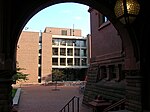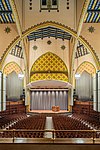Statue of Edgar Fahs Smith
1926 establishments in Pennsylvania1926 sculpturesBronze sculptures in PennsylvaniaMonuments and memorials in PhiladelphiaOutdoor sculptures in Philadelphia ... and 5 more
Sculptures of men in PennsylvaniaStatues in PennsylvaniaUniversity of Pennsylvania campusUse American English from October 2021Use mdy dates from October 2021

Edgar Fahs Smith is a monumental statue located on the campus of the University of Pennsylvania in Philadelphia, Pennsylvania, United States. The statue was designed by sculptor R. Tait McKenzie and honors its namesake, a former provost of the university.
Excerpt from the Wikipedia article Statue of Edgar Fahs Smith (License: CC BY-SA 3.0, Authors, Images).Statue of Edgar Fahs Smith
Grays Ferry Bridge Path, Philadelphia South Philadelphia
Geographical coordinates (GPS) Address Nearby Places Show on map
Geographical coordinates (GPS)
| Latitude | Longitude |
|---|---|
| N 39.951666666667 ° | E -75.192222222222 ° |
Address
University of Pennsylvania
Grays Ferry Bridge Path
19104 Philadelphia, South Philadelphia
Pennsylvania, United States
Open on Google Maps







